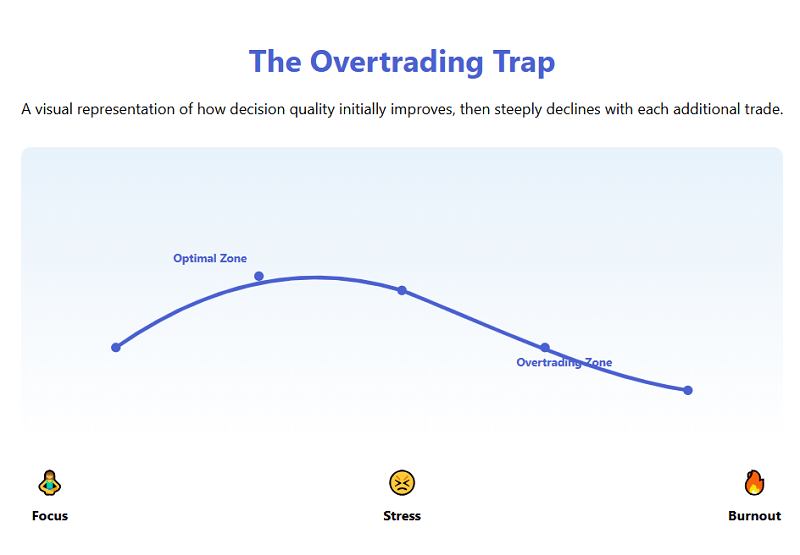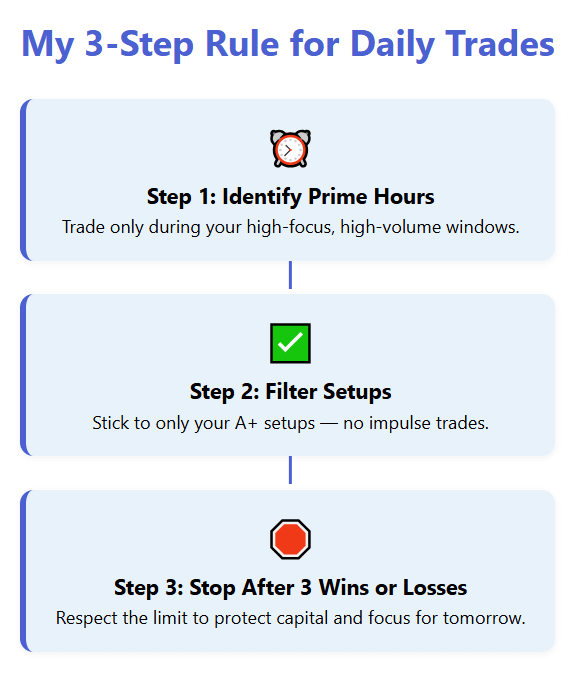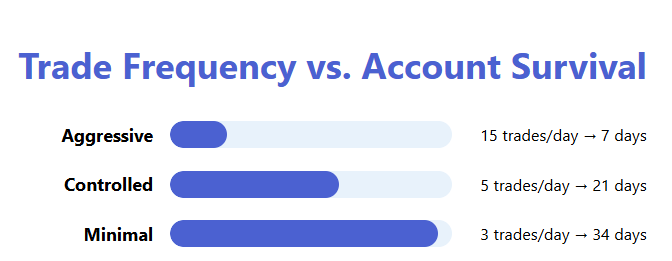How Many Trades Should You Take in a Day?

When I started trading binary options, I used to think more trades meant more chances to win. I’d take ten, sometimes twenty positions in a day, jumping between EUR/USD, GBP/JPY, and even gold. It felt productive, like I was working hard. But soon, I realized I wasn’t building consistency; I was chasing adrenaline.
Binary options trading isn’t about frequency, it’s about precision. Over time, I learned that how many trades you take in a day can decide whether you grow your account or slowly bleed it out.
Start trading smarter, not harder. Open your account now and apply these trade frequency principles in real markets.
The “More Trades, More Profit” Myth
In my early weeks, I believed that the market rewards activity. I’d open positions every 15 minutes, driven by every candle twitch. But when I reviewed my journal, something hit me; my best days weren’t the busiest ones. They were the ones with just two or three carefully planned trades.
The problem with overtrading isn’t just losing trades; it’s losing focus. Every decision drains mental energy, and by the 10th or 12th position, you’re reacting, not thinking.

My Early Mistake
I used to:
- Trade every setup that looked “good enough.”
- Jump between assets to find constant action.
- Chase losses with double positions.
The result? A mix of small wins and huge emotional drawdowns.
How I Found My Daily Trade Limit
After a month of chaos, I decided to test different trading frequencies. For 30 days, I tracked performance under three conditions:
| Trading Frequency | Avg. Daily Trades | Win Rate | Net Result (per week) |
| High frequency | 15–20 | 48% | -6.4% |
| Moderate | 5–7 | 61% | +3.2% |
| Low frequency | 2–3 | 68% | +7.1% |
The data was clear, fewer, higher-quality trades outperformed.
But there was more behind it. It wasn’t just about probability; it was about psychology.
When I took fewer trades, I spent more time preparing, checking support and resistance, validating market sentiment, and waiting for clear price behavior. My patience directly improved my profitability.
My 3-Step Rule for Daily Trade Count
Through experience, I developed a simple system that prevents overtrading while keeping me active enough to capitalize on real opportunities.
Step 1: Identify “Prime Hours”
I trade only when volume and volatility overlap, usually during the London-New York overlap. It’s where price moves are clean and meaningful, not choppy.
Step 2: Quality Over Quantity Filter
Before each trade, I ask:
- Does this setup align with my strategy?
- Is the price reacting at a key level (support/resistance)?
- Do I feel calm and detached, not desperate?
If I can’t answer “yes” to all three, I skip it. That filter alone cuts down 50% of potential trades.
Step 3: Stop After the Third Trade
Three trades a day, that’s my upper limit. Win or lose, I walk away. This rule protects me from decision fatigue and revenge trading.

Emotional Impact of Trade Frequency
Too many traders underestimate the mental cost of overtrading.
The more you trade, the more dopamine cycles you create, and each loss hits harder. By trade number six, logic gives way to emotion.
I noticed that after two consecutive wins, I’d get overconfident. After two losses, I’d start forcing setups to recover. The more trades I took, the faster I slipped into emotional trading loops.
That’s when I understood: my mental energy is a currency as valuable as my capital.
How Many Trades Should You Really Take?
There’s no universal number, but from my experience:
- Beginners: 1–3 trades per day (build discipline).
- Intermediate: 3–5 trades per day (with a proven strategy).
- Advanced: Up to 7, only if setups are validated across timeframes.
You should only increase frequency when you’ve mastered your emotional control and risk limits. Otherwise, more trades just amplify your weaknesses.
Ready to test your trading discipline? Open a demo or live account today and apply the “3-trades-per-day” rule for one week.
What Happens When You Trade Less but Smarter
After I adopted the 3-trade rule, everything changed:
- My equity curve became smoother.
- I started ending days neutral or slightly positive instead of wildly fluctuating.
- I had mental energy left for journaling and reflection.
I also began to see the market better. Waiting taught me patience, and patience improved my accuracy.
| Before (Overtrading) | After (Controlled Trading) |
| 20+ trades daily | 3 trades max |
| Constant emotional swings | Calm, consistent mindset |
| 48% win rate | 68% win rate |
| Frequent account resets | Steady growth |
How I Decide Whether to Take One More Trade
By mid-afternoon, I check two things:
- Am I emotionally stable? (No frustration, no rush)
- Is the setup as clear as the first one I took today?
If either answer is “no,” I stop trading.
Sometimes the best trade is no trade at all, and that’s a truth I had to learn the hard way.
How Trade Frequency Affects Account Survival
Think of your daily trades like bullets in a revolver. The more you fire, the sooner you run out of ammunition, especially if your accuracy is low. I tested this idea by simulating 100 trades under different daily limits:
| Strategy | Max Trades per Day | Duration (Days Before Drawdown) |
| Aggressive (10–15/day) | 15 | 7 |
| Controlled (3–5/day) | 5 | 21 |
| Minimal (1–3/day) | 3 | 34 |
The slower, more selective trader always survives longer. Consistency beats intensity.

Final Thoughts: Fewer Trades, Longer Survival
The question isn’t how many trades you can take, but how many you should.
For me, the sweet spot lies at three. It keeps me engaged but not drained, focused but not fixated. Once I hit my daily limit, I review, record, and rest because sustainable trading isn’t about chasing opportunities; it’s about managing yourself.

Trade with focus, not frequency. Open your trading account today and put the “quality over quantity” rule into action.
Take Control of Your Trading Discipline
Trade smarter. Trade fewer. Trade better.
Start Trading Wisely